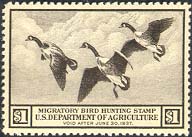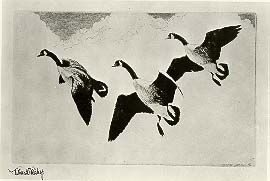

Back to RW2 Back to the Federal Index Home
A LITTLE HISTORY ON THE 3RD (1936-37) DUCK STAMP ARTIST


When Richard E. Bishop graduated from Cornell university in 1909, his degree was not in art, but in engineering. Mr. Bishop always had a natural talent and desire for drawing. Early in his career at a Philadelphia manufacturing plant, he found himself with an inviting pile of copper plates. With the aid of a a phonograph needle, he waxed a plate and scribed the first of many etchings.
Mr. Bishop was born on May 30, 1887, in Syracuse, New York. He was the son of Richard Whitney and Minnie (Blackall) Bishop. After his graduation from Cornell University with a M.E. degree, he first worked as an electrical engineer for the Cutler-Hammer Manufacturing company in Milwaukee. He married Mary Ellen Harrington in 1915.
After a two-year stint with the War Production Board during World War II, Bishop traveled extensively. In 1950 and 1953, two African safaris were organized under the auspices of the American Museum of Natural History in New York for the purpose of recording native birds and animals on sound track and film. Mr. Bishop joined both expeditions, and in addition traveled throughout Great Britain, The Pacific Islands, and North and South America.
His skillfully decorated glassware and china are widely respected, but the beautiful books he produced are cherished by the book lovers. Bishop's Birds was the first complete publication of his work. Published in 1936, it contained 73 Bishop etchings done between 1924 and 1936, and reproduced in aquatone. His next book was Bishop's Waterfowl, published in 1948. It was a collection of reproductions of etchings and oil paintings, with 12 color plates. Prairie Wings, 1962, was a collaboration with Mr. Edgar M. Queeny, and consisted of flight studies with explanatory sketches by Mr. Bishop. From 1945 until just before his death, he produced an annual calendar which was nationally distributed.
Since he was an enthusiastic wildfowler and a top-ranking field shot, it was quite natural that birds should be his subject. Mr. Bishop rendered the wild birds in many art media; watercolors, oil paintings, aquatints, dry points, etchings, jewelry, tiles, metal, glassware, and china. But no matter what medium he chose, his work was based on the knowledge gained from hours of careful study of the birds in their natural habitat. As an engineer and a perfectionist, he wanted to portray the wing action and flight of birds as correctly as possible. He found the answers in highspeed photography, and with characteristic thoroughness took thousands of feet of movie film of birds in flight at the rate of 128 frames per second. His results were some of the finest pictures of birds ever taken.
---------------THE ART---------------
Canada Geese was done as a dry-point etching titled Coming In, executed in 1931. The design was made into an etching and printed on cream paper in brownish black ink. Bishop hand pulled the prints. The edition was pencil signed and unnumbered. The image size of the print is 5"x8".
---------------THE STAMP---------------
Canada Geese...Engraved by the Federal Bureau of Engraving from an original print. Printed in black-brown ink. The stamp sold for one dollar. Postal records show 603,623 stamps sold. First day of sale was July 1, 1936.
Most of the information contained above is from the book Federal Duck Stamp Story, Fifty Years of Excellence, by Laurence F. Jonson; Alexander & Co. It is used here with permission from the author. For more information on this book, please click here.